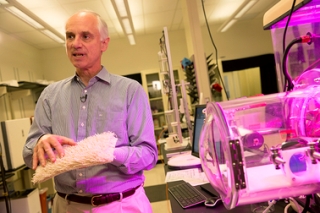Feb 19 2015
What if we had the ability to not only reduce greenhouse gas emissions, but also remove excess carbon dioxide from the atmosphere? If we could, where would we store it, and how could it be used in a positive way?
 Engineering professor Klaus Lackier demonstrates the center's novel air capture technology that features a plastic resin that captures carbon dioxide when wet, and releases when moist. Photo by: Jessica Hochreiter/ASU
Engineering professor Klaus Lackier demonstrates the center's novel air capture technology that features a plastic resin that captures carbon dioxide when wet, and releases when moist. Photo by: Jessica Hochreiter/ASU
A new research center at Arizona State University, led by faculty in the Ira A. Fulton Schools of Engineering, aims to show that capturing excess carbon dioxide from air is a viable strategy to stabilize and reduce greenhouse gases in the atmosphere. It also is a valuable resource that could be recycled to help power the production of synthetic fuels, as well as provide an essential food source for plants in greenhouses.
This air capture technology developed by researchers at the Center for Negative Carbon Emissions transcends the limitations of traditional carbon reduction approaches by actually scrubbing carbon dioxide from the air.
“There is a limit to the amount of carbon dioxide we can have in the atmosphere; if the limit is surpassed, life becomes intolerable,” said Klaus Lackner, the center’s director and a new professor in the School of Sustainable Engineering and the Built Environment, one of ASU’s Ira A. Fulton Schools of Engineering.
“Stabilizing our carbon emissions at net-zero is the only way to avoid crossing the secure threshold. But with global emissions rising, this effort is increasingly expensive and difficult,” Lackner said.
Achieving net-zero emissions requires new technologies, such as air capture, that can manage the carbon balance in the atmosphere by capturing and permanently storing carbon dioxide, resulting in negative carbon emissions.
The center’s novel air capture technology features a plastic resin that captures carbon dioxide when dry, and releases it when moist.
This discovery emerged from collaborative work between Lackner and the center’s executive director Allen Wright while they were at Columbia University and Global Research Technologies, the first privately held air capture company.
Paving the way for carbon recycling
Capturing carbon dioxide for disposal is just part of the agenda for the Center for Negative Carbon Emissions. The center’s researchers also are looking at ways to use what is captured to expand a sustainable economy through efforts like carbon recycling.
“Before we start capturing and storing carbon dioxide on the scale required for negative emissions, we need to prove that air capture is economically efficient,” said Christophe Jospe, the center’s chief strategist.
“Bootstrapping our technology to commercial endeavors where carbon dioxide is a valuable resource is a logical way to promote critical developments in this field,” said Jospe.
Greenhouses and algae-based biofuels which require less concentrated streams of carbon dioxide could enhance their yield using the carbon dioxide collected by the center’s air capture units – making them natural first candidates for efforts to optimize this technology for commercial use. The center also aims to supply carbon dioxide to manufacturers of synthetic fuels, a sustainable alternative to fossil fuels.
Teaming up for sustainable solutions
Lackner, Wright and Jospe moved to ASU from the Lenfest Center for Sustainable Energy at Columbia University to take advantage of the climate and solar energy resources.
“Our technology performs best in dry climates and can be powered by renewable energy. The desert, with abundant solar power and a dry climate, is ideal for us to expand our work from the lab to an outside operating environment,” Wright said.
The Center for Negative Carbon Emissions plans to find its place within the larger sustainable solutions framework at ASU, alongside endeavors such as LightWorks and PlanetWorks, and the Global Institute of Sustainability.
“Technology advances do not happen in a vacuum, and there is world-class innovation in many facets of sustainability here at ASU,” Lackner said. “There is a natural connection between our work and research being done at ASU that can lead to excellent collaborations.”
“We are fortunate to have attracted Lackner and his team to ASU. I feel confident that other research efforts will gain synergy from the work and intellectual capabilities that they bring to the university,” said Edd Gibson, director of the School of Sustainable Engineering and the Built Environment.
The center has already attracted students through outreach with the Fulton Undergraduate Research Initiative (known as FURI), and the faculty members said they look forward to providing more student opportunities for research.
“We offer a holistic systems approach that allows students to get involved in diverse ways, including with the design and construction of various apparatuses, computational simulation, experimental work, automation of processes and political and economic analyses of the availability of this technology,” Jospe said.
Making a case for air capture
Along with pursuing advances in negative carbon emissions, the center’s researchers are eager to increase public awareness about the challenges surrounding the buildup of carbon dioxide in the atmosphere and the achievable solutions negative carbon emissions can provide.
“We are enthusiastic about engaging in the public debate, showing the consequences that different decisions will have and providing opportunities for decision-makers to shape desirable outcomes,” Jospe said.
For the center’s researchers, the urgency of the challenge is clear. “The longer we wait, the more carbon dioxide remains in the atmosphere and the greater the risk of a catastrophic event becomes,” Lackner said.
“Air capture provides a way to clean up after ourselves while making an array of sustainable and carbon management solutions possible,” said Lackner. “But first, we must clearly demonstrate in the public domain that we can and should take up the case for air capture technology.”